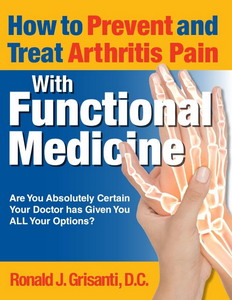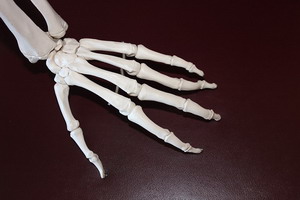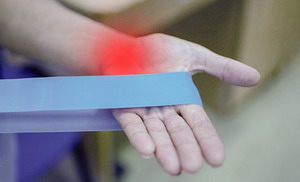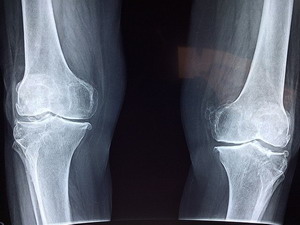Categories
Arthritis


 A couple of weeks ago the trade magazine Chiropractic Economics emailed me a link to a free e-book on treating arthritis. The book was 60 pages long and reviewed several approaches to dealing with arthritis. Since arthritis is certainly a common concern for many patients, I thought I would cover some of the highlights from this publication.
A couple of weeks ago the trade magazine Chiropractic Economics emailed me a link to a free e-book on treating arthritis. The book was 60 pages long and reviewed several approaches to dealing with arthritis. Since arthritis is certainly a common concern for many patients, I thought I would cover some of the highlights from this publication. First things first, the term arthritis is not a diagnostic term but a descriptive term. “Arthro” is Latin for joint and “itis” simply means inflammation. So when a doctor tells you that you have arthritis, what he is really doing is taking your complaint of how your joints hurt and saying that back to you in Latin. The diagnostic part of the diagnosis is the word or prefix in front of the arthritis. There are over 300 different kinds/causes of arthritis. For example “osteo” arthritis, the most common type of arthritis literally means bone joint inflammation. This type of arthritis used to be thought of as “wear and tear” of the joint but now is known to have its roots in an autoimmune attack of the cartilage of the joint. If you hit your thumb with a hammer, this would be called traumatic arthritis. The believed cause for the arthritis is usually the word in front of arthritis. The cause tells us what to do for the pain and swelling.
First things first, the term arthritis is not a diagnostic term but a descriptive term. “Arthro” is Latin for joint and “itis” simply means inflammation. So when a doctor tells you that you have arthritis, what he is really doing is taking your complaint of how your joints hurt and saying that back to you in Latin. The diagnostic part of the diagnosis is the word or prefix in front of the arthritis. There are over 300 different kinds/causes of arthritis. For example “osteo” arthritis, the most common type of arthritis literally means bone joint inflammation. This type of arthritis used to be thought of as “wear and tear” of the joint but now is known to have its roots in an autoimmune attack of the cartilage of the joint. If you hit your thumb with a hammer, this would be called traumatic arthritis. The believed cause for the arthritis is usually the word in front of arthritis. The cause tells us what to do for the pain and swelling. Since there are over 300 causes for joint inflammation (arthritis), there are many different treatments for arthritis. The e-book addressed several common causes and what could be done naturally. One approach to figuring out the underlying cause of your arthritis is taking a bunch of expensive unusual lab tests. While this approach provides the doctor with greater confidence that what he suggests will be effective, its greatest benefit lies in convincing the patient that they really must do the things they don’t want to do if they want to get better. Personally, I come from the “body hacking” school of thought where my diet and lifestyle are constantly being varied in my efforts to optimize my health. “Trial and error” is my middle name.
Since there are over 300 causes for joint inflammation (arthritis), there are many different treatments for arthritis. The e-book addressed several common causes and what could be done naturally. One approach to figuring out the underlying cause of your arthritis is taking a bunch of expensive unusual lab tests. While this approach provides the doctor with greater confidence that what he suggests will be effective, its greatest benefit lies in convincing the patient that they really must do the things they don’t want to do if they want to get better. Personally, I come from the “body hacking” school of thought where my diet and lifestyle are constantly being varied in my efforts to optimize my health. “Trial and error” is my middle name. Health is a constantly moving target. There is no one “right” way in the body because we are designed to constantly adapt to life’s circumstances. I suppose if I were a seaweed in a part of the ocean where the water was always calm, the same temperature, and a constant supply of nutrients in the water, then there might be a one right optimal way for me. But I am not seaweed and my life brings me constant variety for my body to contend with. We need to be constantly adapting our diet and lifestyle to match the needs we have and the stressors we contend with.
Health is a constantly moving target. There is no one “right” way in the body because we are designed to constantly adapt to life’s circumstances. I suppose if I were a seaweed in a part of the ocean where the water was always calm, the same temperature, and a constant supply of nutrients in the water, then there might be a one right optimal way for me. But I am not seaweed and my life brings me constant variety for my body to contend with. We need to be constantly adapting our diet and lifestyle to match the needs we have and the stressors we contend with. The first big area to look at with arthritis is the basic biology of inflammation. What feeds inflammation? Chemically, what creates inflammation? One of the biggest pathways is concerned with chemicals called prostaglandins. There are inflammatory prostaglandins which are basically made from omega 6 oils and anti-inflammatory prostaglandins made from omega 3 oils. These two oils should be in balance in our diet and in our bodies. But the American lifestyle has pushed the “bad guys” way up in our diet to where some folks are getting 20 times as much inflammatory omega 6 oils as omega 3 oils. At this point, everyone knows to get more omega 3 oils by eating salmon or taking krill oil capsules. But most do not know that this is worthless unless you also get rid of the excess omega 6 oils in your diet. That means getting rid of all vegetable oils – no fried foods, mayo, margarine, most packaged or fast food, and so on. Avocado, olive, butter, coconut, and lard are okay fats, but everything else is not. This would be the first step in addressing any inflammation in your body, including arthritis. Get rid of the omega 6 oils in your diet.
The first big area to look at with arthritis is the basic biology of inflammation. What feeds inflammation? Chemically, what creates inflammation? One of the biggest pathways is concerned with chemicals called prostaglandins. There are inflammatory prostaglandins which are basically made from omega 6 oils and anti-inflammatory prostaglandins made from omega 3 oils. These two oils should be in balance in our diet and in our bodies. But the American lifestyle has pushed the “bad guys” way up in our diet to where some folks are getting 20 times as much inflammatory omega 6 oils as omega 3 oils. At this point, everyone knows to get more omega 3 oils by eating salmon or taking krill oil capsules. But most do not know that this is worthless unless you also get rid of the excess omega 6 oils in your diet. That means getting rid of all vegetable oils – no fried foods, mayo, margarine, most packaged or fast food, and so on. Avocado, olive, butter, coconut, and lard are okay fats, but everything else is not. This would be the first step in addressing any inflammation in your body, including arthritis. Get rid of the omega 6 oils in your diet. The second big area of study was once just a fringe belief but since has been soundly proven to be a real and a serious issue for arthritis sufferers – nightshades. A significant number of arthritis sufferers owe their pain to a negative inflammatory reaction to the nightshade vegetables. These include tomatoes, potatoes, chilies, eggplants, peppers, and tobacco. Yeah, smoking is a major trigger for arthritis, as is eating spaghetti sauce, French fries, salsa, and crunching on a lovely yellow bell pepper. In clinical studies that have been repeated many times, about two-thirds of arthritis sufferers who completely eliminate their exposure to nightshade vegetables for 2 to 3 months find a tremendous improvement in their pain and swelling. Give this a try. If it helps you feel better, then nightshade vegetables are not for you, ever. If you go back to eating these foods then your symptoms usually return full force within a few days. These foods can hide in lots of unexpected places, like potato starch in vitamin or medicine capsules. A search online can guide you in finding all the places these veggies hide out.
The second big area of study was once just a fringe belief but since has been soundly proven to be a real and a serious issue for arthritis sufferers – nightshades. A significant number of arthritis sufferers owe their pain to a negative inflammatory reaction to the nightshade vegetables. These include tomatoes, potatoes, chilies, eggplants, peppers, and tobacco. Yeah, smoking is a major trigger for arthritis, as is eating spaghetti sauce, French fries, salsa, and crunching on a lovely yellow bell pepper. In clinical studies that have been repeated many times, about two-thirds of arthritis sufferers who completely eliminate their exposure to nightshade vegetables for 2 to 3 months find a tremendous improvement in their pain and swelling. Give this a try. If it helps you feel better, then nightshade vegetables are not for you, ever. If you go back to eating these foods then your symptoms usually return full force within a few days. These foods can hide in lots of unexpected places, like potato starch in vitamin or medicine capsules. A search online can guide you in finding all the places these veggies hide out. Further research has shown that food sensitivities of any sort often cause joint inflammation, so any food allergy or sensitivity can trigger arthritis. Tracking these down takes serious effort and diligence. The gold standard is to go on a mono diet, meaning eating only one food like beef for several weeks until symptoms settle down, then adding in one new food every three days and watching for any symptoms to appear. Gradually you can discover what foods work for you and what do not.
Further research has shown that food sensitivities of any sort often cause joint inflammation, so any food allergy or sensitivity can trigger arthritis. Tracking these down takes serious effort and diligence. The gold standard is to go on a mono diet, meaning eating only one food like beef for several weeks until symptoms settle down, then adding in one new food every three days and watching for any symptoms to appear. Gradually you can discover what foods work for you and what do not. The third big area for arthritis sufferers to consider is your gut health. What? How do our guts have anything to do with our knees or fingers? Well, our gut health is about the same thing as our immune system health. It is our immune system that is at the bottom of all inflammatory issues. Inflammation is how our body mobilizes the immune system to an area that is under attack or has been damaged. This piece has many attributes to it. But there is a direct relationship between gut issues like IBS and Crohn’s disease and joint inflammation. There are patterns of bad gut bacteria growth that show up as joint inflammation. Leaky gut allows inflammatory molecules into our bloodstream that can “stick” to our joint tissues and cause the immune system to attack our joints in an autoimmune attack. Rheumatoid arthritis is one such autoimmune disease that affects our joints. Autoimmune disease basically starts in the gut with leaky gut disorder. Even osteoporosis is now understood to be an autoimmune disease, so the very bone that forms the joint can be under attack. I have written several newsletters on the importance of addressing leaky gut and how to do that. Basic is eliminating any sources of glyphosate (Roundup) contaminated foods along with gluten and casein-containing foods. A particular supplement that has been found to be particularly powerful in treating Rheumatoid arthritis is called cetyl myristoleate, which seems to be able to reprogram faulty memory T-cells which regulate our immune system.
The third big area for arthritis sufferers to consider is your gut health. What? How do our guts have anything to do with our knees or fingers? Well, our gut health is about the same thing as our immune system health. It is our immune system that is at the bottom of all inflammatory issues. Inflammation is how our body mobilizes the immune system to an area that is under attack or has been damaged. This piece has many attributes to it. But there is a direct relationship between gut issues like IBS and Crohn’s disease and joint inflammation. There are patterns of bad gut bacteria growth that show up as joint inflammation. Leaky gut allows inflammatory molecules into our bloodstream that can “stick” to our joint tissues and cause the immune system to attack our joints in an autoimmune attack. Rheumatoid arthritis is one such autoimmune disease that affects our joints. Autoimmune disease basically starts in the gut with leaky gut disorder. Even osteoporosis is now understood to be an autoimmune disease, so the very bone that forms the joint can be under attack. I have written several newsletters on the importance of addressing leaky gut and how to do that. Basic is eliminating any sources of glyphosate (Roundup) contaminated foods along with gluten and casein-containing foods. A particular supplement that has been found to be particularly powerful in treating Rheumatoid arthritis is called cetyl myristoleate, which seems to be able to reprogram faulty memory T-cells which regulate our immune system. Along these same lines was some advice on supporting the immune system with such things as vitamin D. In some studies 50% of people experienced joint improvements when they got their Vitamin D levels up to 60 to 80 ng/dl in their blood. Interestingly people that are obese or have had their gallbladders removed or gastric bypass surgery need lots more vitamin D than regular folks.
Along these same lines was some advice on supporting the immune system with such things as vitamin D. In some studies 50% of people experienced joint improvements when they got their Vitamin D levels up to 60 to 80 ng/dl in their blood. Interestingly people that are obese or have had their gallbladders removed or gastric bypass surgery need lots more vitamin D than regular folks. Another oldie but goodie is using glucosamine and chondroitin sulfate for helping the joints. Originally the thought was that since there is a lot of these in cartilage tissue, that taking these would help heal the joints. The modern view is quite different. Certain plant lectins (poisons) specifically attach to these substances in our joints causing an immune reaction. By taking these supplements orally with meals, they act as a decoy and bind up these nasty lectins before they are able to get into our bloodstream, thus saving our joints.
Another oldie but goodie is using glucosamine and chondroitin sulfate for helping the joints. Originally the thought was that since there is a lot of these in cartilage tissue, that taking these would help heal the joints. The modern view is quite different. Certain plant lectins (poisons) specifically attach to these substances in our joints causing an immune reaction. By taking these supplements orally with meals, they act as a decoy and bind up these nasty lectins before they are able to get into our bloodstream, thus saving our joints. Another powerful anti-inflammatory discussed for helping with joint inflammation is a fatty acid derived from green-lipped muscles, called Liprinol. Research has found it to be more powerful than NSAIDs without all the negative side effects. It should be noted that arthritis is one of the actual side effects of taking NSAIDs (ibuprofen, aspirin, Indomethacin, Advil, Naproxen). One study found a 93% reduction in pain and swelling outperformed the NSAIDs by 2 to 1. Systemic enzyme therapy was also noted as having great results with patients. These are not simple digestive enzymes but enzymes designed to enter our bloodstream specifically to fight inflammation. Herbs like ginger, Boswellia, and Cat’s Claw for joint pain were also mentioned. The e-book even showed many acupressure points to help out the joints.
Another powerful anti-inflammatory discussed for helping with joint inflammation is a fatty acid derived from green-lipped muscles, called Liprinol. Research has found it to be more powerful than NSAIDs without all the negative side effects. It should be noted that arthritis is one of the actual side effects of taking NSAIDs (ibuprofen, aspirin, Indomethacin, Advil, Naproxen). One study found a 93% reduction in pain and swelling outperformed the NSAIDs by 2 to 1. Systemic enzyme therapy was also noted as having great results with patients. These are not simple digestive enzymes but enzymes designed to enter our bloodstream specifically to fight inflammation. Herbs like ginger, Boswellia, and Cat’s Claw for joint pain were also mentioned. The e-book even showed many acupressure points to help out the joints. As you can see, arthritis is not a simple subject, and one many folks have been trying to remedy for many years. There are many kinds of arthritis and as a result, many different remedies that might help. The idea is that any one of these might be the ideal remedy for your case, or a combination might be necessary. One of the simplest and oldest remedies is just movement. The worst thing you can do for a joint is to stop using it. Joints have a very poor blood supply, so the oxygen and nutrients they need to stay healthy require movement to get the joint fluid to carry these needs to the inner parts of the joint. An inflamed joint might not be able to tolerate impact or compression while inflamed, but they almost always enjoy passive motion, like in swimming, bike riding, Yoga, and other gentle joint movements. Also critical is joint balance, so the pressures are evenly distributed within the joint. This means good coordination of the muscles and nerves around the joint.
As you can see, arthritis is not a simple subject, and one many folks have been trying to remedy for many years. There are many kinds of arthritis and as a result, many different remedies that might help. The idea is that any one of these might be the ideal remedy for your case, or a combination might be necessary. One of the simplest and oldest remedies is just movement. The worst thing you can do for a joint is to stop using it. Joints have a very poor blood supply, so the oxygen and nutrients they need to stay healthy require movement to get the joint fluid to carry these needs to the inner parts of the joint. An inflamed joint might not be able to tolerate impact or compression while inflamed, but they almost always enjoy passive motion, like in swimming, bike riding, Yoga, and other gentle joint movements. Also critical is joint balance, so the pressures are evenly distributed within the joint. This means good coordination of the muscles and nerves around the joint. So the bottom line is if your doctor tells you that you have arthritis, that is where you start. Arthritis is not a diagnosis of a disease you just live with. Arthritis is a pain signal that your body is giving you that tells you something is out of balance somewhere that needs addressing. A diagnosis of arthritis is the beginning of the journey, not the end.
So the bottom line is if your doctor tells you that you have arthritis, that is where you start. Arthritis is not a diagnosis of a disease you just live with. Arthritis is a pain signal that your body is giving you that tells you something is out of balance somewhere that needs addressing. A diagnosis of arthritis is the beginning of the journey, not the end.